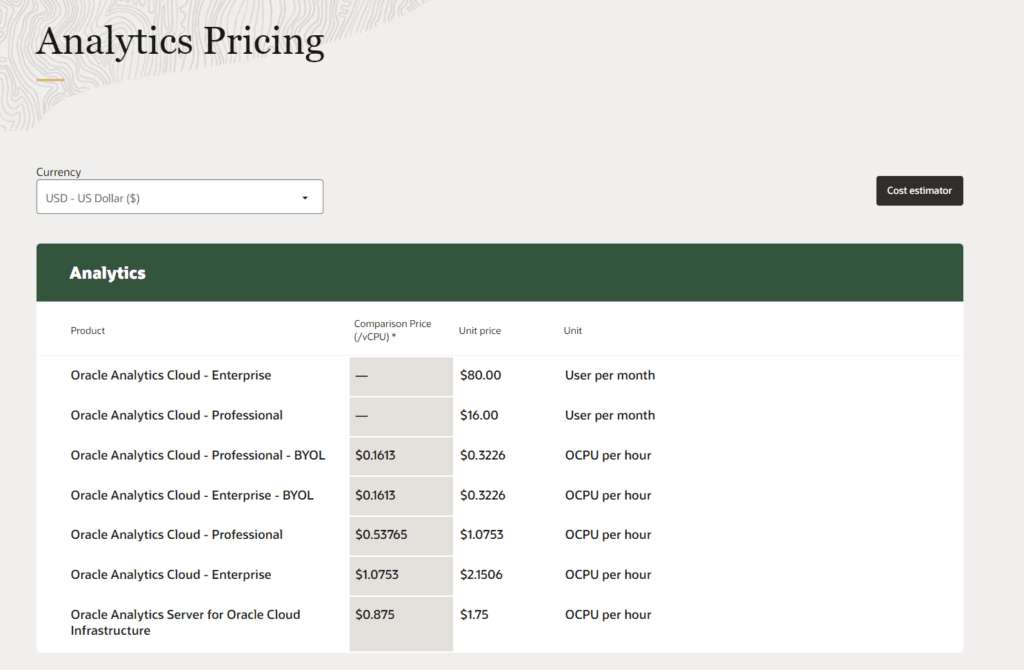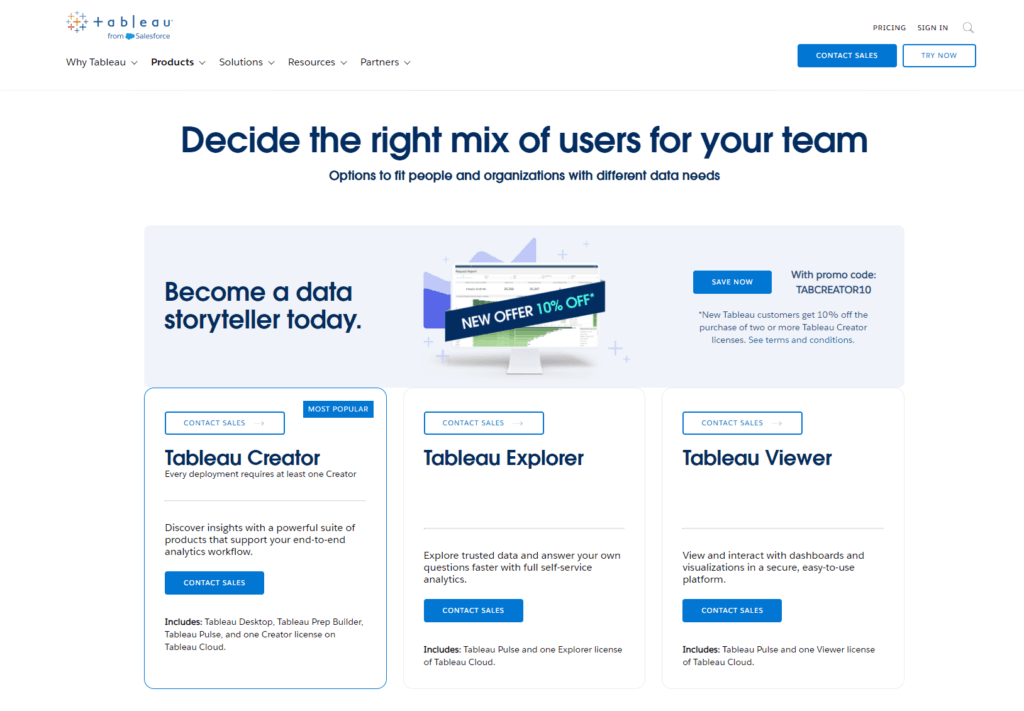Hey there! Are you in a bit of a pickle trying to decide between Oracle Analytics Cloud (OAC) and Tableau for your data analytics needs? Well, you’re not alone. Choosing the right analytics tool can feel like searching for a needle in a digital haystack. Fear not! We’re here to break down the nitty-gritty of OAC and Tableau in plain English, helping you make an informed decision without the headache. So, grab your favorite snack, get comfy, and let’s unravel the mystery together. By the end of this journey, you’ll be closer to choosing the analytics companion that’s just right for your business.
| Oracle Analytics Cloud | Tableau |
|---|---|
 |  |
| G2 Score -4.0 out of 5 | G2 Score -4.4 out of 5 |
| TrustRadius Score -8.1 out of 10 | TrustRadius Score -8.2 out of 10 |
Ease of Use and User Interface
When it comes to analytics tools, the ease of use and the intuitiveness of the user interface (UI) can make a huge difference in how quickly you can turn data into decisions. Let’s take a closer look at how Oracle Analytics Cloud and Tableau stack up in this domain.
Oracle Analytics Cloud: A Comprehensive Suite
Oracle Analytics Cloud is like the Swiss Army knife of analytics – it’s packed with features for every conceivable analytics need. With such power comes complexity, but OAC has been working hard to streamline its user experience. The platform offers a web-based UI that is both sleek and functional, with dashboards that can be as simple or as detailed as you need them to be. OAC is designed to cater to both data scientists and business analysts, offering drag-and-drop functionalities for creating visualizations alongside advanced options for deeper data exploration.
The catch? New users might find the platform’s robust capabilities a bit overwhelming at first. There’s a learning curve, but it’s accompanied by comprehensive support resources to help you climb it. Oracle provides extensive documentation, tutorials, and community forums to assist users in navigating the platform’s extensive features.
Tableau: Intuitive Design for Quick Insights
Tableau, on the other hand, has been a crowd favorite for its focus on user experience and intuitive design from the get-go. Its interface is all about making data analytics accessible, with a strong emphasis on visual exploration. Users can quickly create visually appealing and interactive dashboards with a few clicks, making it easier to share insights across teams and organizations.
Tableau’s approachable design doesn’t just cater to beginners; it also offers deep analytical capabilities for those who want to dive deeper. The platform balances simplicity and sophistication, allowing users to easily connect to data sources, create dashboards, and explore data without feeling bogged down by complexity.
Pricing Considerations
The pricing models of OAC and Tableau are structured to accommodate the varied needs of their respective target audiences, from small businesses to large enterprises. Let’s break down the pricing strategies of both platforms to help you gauge which might align better with your financial planning.
Oracle Analytics Cloud: Enterprise-Oriented Pricing Model

Oracle Analytics Cloud is tailored to meet the demands of large-scale enterprise analytics, with a pricing model that reflects its comprehensive suite of features and services.
OAC operates on a subscription-based model, where fees are typically determined by the scale of data processing, storage needs, and the number of users. This model is designed to offer flexibility and scalability, allowing businesses to adjust their subscription as their analytics requirements change.
Given the customizable nature of OAC, Oracle encourages direct engagement for pricing inquiries to ensure that businesses only pay for the features and capacities they need. Additionally, organizations should consider potential costs related to data migration, integration, and any specific customization or consulting services required.
Tableau: Flexible Pricing for a Broad User Base

Tableau’s pricing model is devised to cater to a wide range of users, from individual analysts to multinational corporations, emphasizing flexibility and accessibility. Tableau offers a tiered pricing structure that includes different plans for individual users, teams, and organizations.
Each tier provides specific features and capabilities, from Tableau Desktop for individual use to Tableau Server and Tableau Online for collaborative team and organizational analytics. One of Tableau’s strengths is the transparency of its pricing, with detailed information readily available on its website. This transparency helps businesses and individuals estimate their investment upfront, making budget planning more straightforward.
Data Integration and Management
The ability to seamlessly integrate data from various sources and efficiently manage that data is a cornerstone of effective analytics. Both Oracle Analytics Cloud and Tableau offer powerful capabilities in this area, but their approaches and strengths vary.
Oracle Analytics Cloud: Seamless Integration Across the Oracle Ecosystem and Beyond
OAC excels in its ability to integrate with a wide array of data sources, including other Oracle products, third-party cloud services, on-premises databases, and even spreadsheets. This is a significant advantage for organizations already invested in Oracle’s ecosystem, as OAC provides a cohesive and integrated analytics experience across various Oracle applications.
Beyond its integration capabilities, OAC offers robust data management tools that allow users to cleanse, transform, and enrich data within the platform. This means that data from different sources can be standardized and prepared for analysis without needing to exit the Oracle environment. For businesses dealing with large volumes of data or complex data landscapes, OAC’s comprehensive data management features streamline the process from integration to insight.
Tableau: Flexibility and Ease of Connection to Multiple Data Sources
Tableau is renowned for its flexibility in connecting to almost any data source imaginable, from databases and spreadsheets to cloud services and web data connectors. This flexibility makes Tableau a versatile tool for organizations that gather data from a broad mix of sources and require a platform that can adapt to their diverse data ecosystem.
While Tableau provides powerful tools for data integration, its approach to data management emphasizes user-friendliness and accessibility. Users can easily blend data from different sources directly within the platform, creating a unified view of their information without extensive data preparation or transformation efforts. Tableau’s intuitive interface allows users to focus more on analysis and less on the technicalities of data management, making it an attractive option for teams looking for quick insights.

Related: Check out our free SEO suite

Scalability and Performance Comparison
Evaluating the scalability and performance of Oracle Analytics Cloud (OAC) and Tableau is essential for businesses planning for growth and looking for a tool that can handle increasing data and user demands efficiently.
Oracle Analytics Cloud: Built for Enterprise Scalability
OAC leverages Oracle’s cloud infrastructure, designed to support large-scale operations, allowing it to offer outstanding scalability. This setup ensures that businesses can scale their analytics operations according to their needs, maintaining high performance even as data volumes and complexity grow. Oracle’s infrastructure is optimized for handling extensive data sets efficiently, enabling complex analyses and quick insight generation.
With its enterprise-grade architecture, OAC is particularly suitable for large companies anticipating significant scaling in their analytics operations. The platform’s scalability and Oracle’s extensive global cloud infrastructure make it a reliable choice for organizations requiring robust analytics capabilities.
Tableau: Versatile Scalability for Various Business Sizes
Tableau’s approach to scalability is versatile, offering deployment options (desktop, server, cloud-based) that cater to different business sizes and scalability requirements. Tableau is recognized for its efficient data processing, enabling real-time, interactive data visualization. This adaptability allows companies to expand their use of Tableau, adjusting to cloud-based solutions or adding more servers as their growth demands.
The flexibility in Tableau’s scalability options appeals to a broad audience, from startups to extensive enterprises. Its ability to deliver reliable performance across various deployments offers the agility businesses need to adjust to their changing analytics requirements.
Support and Community
When selecting an analytics tool, considering the type and quality of support available, as well as the presence of an active user community, is crucial for both new and experienced users.
Oracle Analytics Cloud: Comprehensive Support with a Robust Ecosystem
Oracle Analytics Cloud benefits from Oracle’s extensive support infrastructure, offering various levels of support depending on the subscription plan. Customers can access Oracle’s support services, including technical assistance, troubleshooting, and guidance on best practices. Oracle’s global presence ensures that support is available across different time zones, providing timely assistance to businesses worldwide.
OAC is supported by a robust ecosystem that includes a vast user community, forums, and Oracle’s own knowledge base. This community serves as a valuable resource for users seeking advice, sharing experiences, or solving complex problems. Oracle also offers extensive documentation and learning resources, including tutorials and training sessions, to help users maximize their use of the platform.
Tableau: Vibrant Community and Responsive Support
Tableau is known for its responsive and helpful customer support, which is critical for businesses relying on analytics for decision-making. Tableau provides various support tiers, including free online resources, dedicated customer support for troubleshooting, and premium support options for enterprise customers. Tableau’s support is geared towards enabling users to effectively utilize the platform, offering help ranging from technical issues to strategic guidance on visualization best practices.
One of Tableau’s strengths is its vibrant user community, known for its engagement and willingness to help. The Tableau community includes user forums, social media groups, and local user groups, where members share insights, offer solutions, and collaborate on best practices. This active community not only enhances the user experience but also fosters a culture of learning and innovation among Tableau users.
Conclusion
In concluding our in-depth comparison between Oracle Analytics Cloud (OAC) and Tableau, we’ve journeyed through several critical considerations that shape the decision-making process when selecting an analytics tool. From ease of use and user interface, data integration and management capabilities, to scalability, performance, support, community, and finally, pricing—each aspect plays a vital role in determining which platform best aligns with your organization’s needs.
READ NEXT:
- MicroStrategy vs SAS Visual Analytics: The Best Analytics Tool for You
- Oracle Analytics Cloud vs Statcounter: The Best Analytics Tool for You
- MicroStrategy vs Microsoft Power BI: The Best Analytics Tool for You
- Crazy Egg vs Adobe Analytics: The Best Analytics Tool for You
- Microsoft Power BI vs Optimizely: The Best Analytics Tool for You
- 11 Marketing Analytics Tools to Elevate Your Data-Driven Strategies
- 29+ Digital Analytics Software to Skyrocket Your Digital ROI






















Comments are closed.